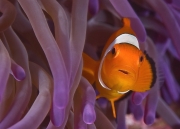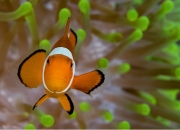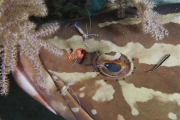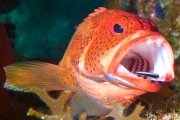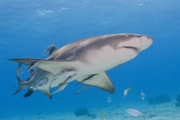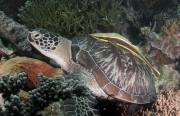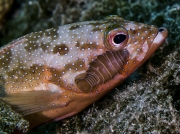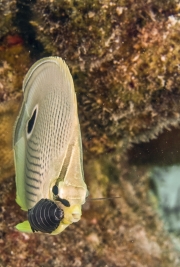Symbiotic relationships are as fascinating as they are critical to the survival of all living organisms. Symbiosis literally means “with living” and occurs when two different living species live together in a very close relationship. Life on Earth would not exist without symbiotic relationships. Symbiotic relationships exist in three forms: mutualism, commensalism, and parasitism. In symbiotic relationships there is a host organism and an organism that chooses to live or hang out with a host. This organism is called the “symbiont.” So, in all symbiotic relationships, we refer to either the “host” or the “symbiont.”
In mutualistic relationships, both the host and symbiont benefit and help each other to survive and stay healthy. Marine examples include anemonefish (clown fish) living with their host anemone and cleaning stations where cleaner shrimp and fish remove parasites from larger fish. Anemonefish nestle, breed, and live in the poisonous tentacles of their sea anemone. The anemonefish have built up immunity from the stinging cells (nematocysts) on the anemone’s tentacles, but other fish and small prey are not immune. In return for protection and safety from predators, the anemonefish actually help take fish that have been killed by the anemone’s stinging cells and feed its host anemone. In other examples of mutualism, large fish will actually swim into a marine “cleaning station” and become very still. These fish then attract small shrimp and cleaning fish that remove small parasites from the inside of the gills and mouth of the large fish. In all these examples of mutualism, both organisms – the host and the symbiont – mutually benefit and help each other.
Commensalism is seen a bit more rare. This is where the symbiont benefits and the host is mostly unaffected and not harmed. A classic marine example of commensalism is seen when remoras swim under and/or attach themselves to a host shark with their head plate. The remoras may be a nuisance for the shark, but the shark is neither harmed nor helped by the remoras. The remoras, on the other hand, are in a prime location to grab scraps from prey eaten by the shark. The remoras stay just out of the shark’s reach. Another example is a remora that has attached itself with its head plate to the shell of a turtle. I don’t think the turtle particularly likes the remora, but it neither harms nor helps the turtle. Favorite food sources for many turtles are sponges. You can often see angelfish hanging out with a turtle as it rips off pieces of sponge from the reef – the angelfish are then able to pick up uneaten small pieces of sponge that float their way.
Parasitism is not such a good relationship for the host. Parasites (symbiont) such as worms and isopods always benefit from their relationship with their host, but parasites can cause great harm and even kill their host. The butterfly fish swimming with the isopods on and around its eyes certainly is not beneficial for the butterfly fish or the grouper. Like humans and other animals, worms and intestinal parasites have deadly implications.
The examples below illustrate the three kinds of symbiotic relationships described above.
